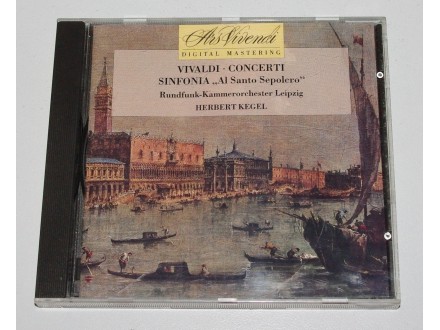Antonio Vivaldi - Concerti - Sinfonia Al Santo Sepolcro
| Cena: |
| Stanje: | Polovan bez oštećenja |
| Garancija: | Ne |
| Isporuka: | Pošta Post Express Lično preuzimanje |
| Plaćanje: | Tekući račun (pre slanja) Pouzećem Lično |
| Grad: |
Mužlja, Zrenjanin |
Godina izdanja: 1989
Izdavač: Ars Vivendi - Deutsche Schallplatten Berlin
Žanr: Klasična muzika
Poreklo: Strani izvođač
Made in West Germany.
Booklet na 8 strana.
Disk u odličnom stanju.
Label: Ars Vivendi - Deutsche Schallplatten Berlin 4101380000546
Format: CD, Album
Country: Germany
Released: 1989
Genre: Classical
Style: Baroque
Conductor: Herbert Kegel
Rundfunk-Kammerorchester Leipzig
Antonio Vivaldi`s Sinfonia al Santo Sepolcro in B minor, RV 169, is one of two pieces he composed bearing the subtitle `al Santo Sepolcro,` the other being a Sonata in E flat major, RV 130. Both works are scored for two violins, viola, and continuo, although it is generally accepted that the Sinfonia may be played by either orchestral or chamber forces. There are many chapels in Italy that are called `al Santo Sepolcro` (of the Holy Sepulchre), but given the provenance of the undated Vivaldi manuscript in Turin, it may have been written for a chapel incorporated as part of the Sacro Monte complex in nearby Varallo, Italy. Built in 1491 by Franciscan monk Bernardo Calmì, this chapel is a scaled-down replica of the Church of the Holy Sepulchre in Jerusalem that sits on top of the place where it is believed that Christ was entombed. Italian Pilgrims hoping to travel to the Holy Land in the late fifteenth century were discouraged by war raging with the Turks; the Varallo chapel was built with the intention of providing a reasonable substitute for the real thing. Ultimately the chapel was joined by 43 other buildings forming a `new Jerusalem` and signifying the history of salvation; many of these were decorated by Renaissance master painter Gaudenzio Ferrari. The final chapel at Sacro Monte was not completed and opened until 1728; perhaps this provides the occasion for Vivaldi`s compositions `al Santo Sepolcro.`
The Sinfonia al Santo Sepolcro is couched in a harmonic language that is thorny even for Vivaldi -- in the opening measures of the Adagio molto the music passes through a unison pitch, a minor second, and a tri-tone to arrive at its first B minor chord. The rest of the opening is harmonically unstable in the extreme, but is not out of character for what was known as `passion music` in the Baroque -- a highly chromatic idiom reserved for representing Christ`s pain and suffering. The concluding Allegro ma pocco passes through similar territory with rapid-fire figures wending their way in a call and response-type pattern. Though it`s all over in only three or four minutes, the Sinfonia al Santo Sepolcro represents Vivaldi at his most intense and dramatic, which explains why it is becoming among the most popular of Vivaldi`s works outside of his major opus numbered sets.
Predmet: 59743807











